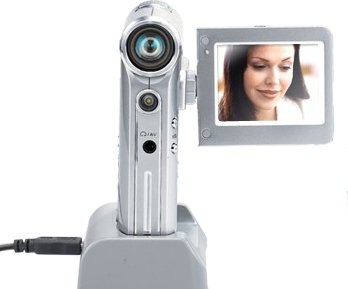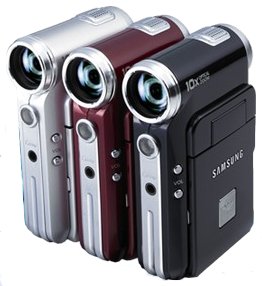Device Profile: Samsung Miniket multi-function diskless camcorder
Jan 26, 2005 — by LinuxDevices Staff — from the LinuxDevices Archive — 38 viewsSamsung has used uClinux and an ARM9-based SoC to build a tiny multi-function device that serves as a high-quality diskless camcorder, SVGA digital camera, mp3 player, voice recorder, data storage device, and web cam. The Miniket runs a 2.6-series “ARM-no-MMU” uClinux kernel that can boot to a shell in 80msec.

Samsung's Miniket includes a recharging cradle
What'll she do?
 The Miniket is available in three models, with internal storage capacities of 256MB, 512MB, and 1GB. The device is “the size of a king of spades,” according to Samsung, and weighs 5 ounces (147 grams) with battery. The small device can perform a surprising range of functions, according to Samsung, including the following:
The Miniket is available in three models, with internal storage capacities of 256MB, 512MB, and 1GB. The device is “the size of a king of spades,” according to Samsung, and weighs 5 ounces (147 grams) with battery. The small device can perform a surprising range of functions, according to Samsung, including the following:
Diskless camcorder
Used as a diskless camcorder, the Miniket can capture D1-resolution video (720 x 480, the same resolution as DVDs) at 30 frames/sec, with audio, Samsung says. The 1GB model can record one hour of “High Quality” video.
Movie length can be extended using removable storage cards. The Miniket includes a MultiCard slot that supports Memory Stick and Memory Stick Pro cards. Memory Stick and its faster Pro variant are typically supported by digital cameras and other consumer devices from Sony. Memory Sticks are currently available from SanDisk and Sony in capacities up to 4GB, typically priced slightly higher per megabyte than CompactFlash cards.
The Miniket encodes and compresses video using a codec included in the MPEG4 standard. Its video files can be played back using Windows Media Player 6.4 or later, or on Samsung's DVD recorders, the company says.
The camera features a 10-power optical zoom, along with 100-power digital zooming. It also includes electrical image stabilization, said to mitigate the effects of camera vibration, for example when shooting from a moving car. A number of video effects can be selected, including sepia, mosaic, art, negative, mirror, and emboss.
Digital Camera
The Miniket supports still photo captures at SVGA-resolution (800 x 600). It includes a built-in flash, just below the lens. It can print directly to USB printers that support PictBridge. Photos can be played back on the device's tilt-and-swivel color LCD, transfered to removable storage cards, or copied to a PC over a USB mass storage device connection. USB mass storage support also allows the device to be used for generic data storage.
MP3 player, voice recorder and… webcam
 The 512MB Miniket model can store up to 128 MP3 files, Samsung says. The device includes a headphone jack, and audio files can also be played back through a built-in speaker.
The 512MB Miniket model can store up to 128 MP3 files, Samsung says. The device includes a headphone jack, and audio files can also be played back through a built-in speaker.
The Miniket includes a built-in microphone, and can serve as a voice recorder with simple one-button operation, Samsung says. The 1GB model can store up to 18 hours of voice recording. A file locking feature prevents accidental deletion of important voice notes, the company says.
Attached to a PC via a USB cable, the Miniket can also function as a webcam, Samsung says.
What's under the hood?
The Miniket is based on a Samsung S5C7376 SoC (system-on-chip) clocked at 216MHz. The SoC includes an ARM9 core with MMU; however, the Miniket's uClinux 2.6 kernel does not use the chip's MMU. This is because research at Samsung showed that context switches and IPCs (inter-process communications) are faster under uClinux on processors that have virtually indexed caches and a TLB (translation lookaside buffer) without address space tags.
The Miniket boots from 128KB of NOR Flash, and includes 16MB of SDRAM. As noted above, various models offer different amounts of user file storage, which is based on a single internal NAND Flash chip. The 128KB NOR Flash is only used for bootloader functions; all other system software, including the kernel, is stored within the much larger NAND Flash.
The Miniket's internal NAND chip is formatted using a FAT (file allocation table) compatible filesystem that supports bit-stream recording at speeds up to 8MB per second, according to Samsung System Engineer Hyok S. Choi, who designed the Miniket's system architecture and developed the kernel, bootloader, custom message-queue, and real-time AV encoding and storing device drivers. Choi spoke about the Miniket at yesterday's CELF symposium.
Software side
The Miniket runs a uClinux/ARM 2.6 kernel based in part on the uClinux/ARM 2.6 project, which Choi leads. According to Choi, the project used the Samsung S5C737x SoC as its primary target processor, and all the GPL'd parts of the kernel used in the Miniket are available for download from the project site. The Miniket is the first of several Samsung products that will be based on an “ARM-no-MMU” uClinux kernel.
According to Choi, a vanilla version of the uClinux/ARM 2.6 kernel can boot to a sash shell in 80msec. The Miniket can boot to its main() function in 0.8 seconds, Choi adds.
The Miniket's firmware features an extremely small footprint, with uncompressed sizes listed by Choi as follows:
- uClinux Kernel — 403KB
- FS for NAND module — 110KB
- device driver modules — 337KB
- main app — 588KB
- UI resources — 1.6MB
According to Choi, a team of twelve developed the Miniket's uClinux-based firmware in-house, without help from a commercial Linux support provider. Two developers focused on Linux system programming, with the others working on the camera, EIS, interface, and various device drivers. Choi says the team delivered a production-ready image eight months after the SoC had been tested using a prototype based on an FPGA.
To learn more about the uClinux/ARM 2.6 kernel used in the Miniket, be sure to visit the project's webpage. For more about the performance advantages of uClinux on certain ARM9 processors, be sure to read Choi's whitepaper.
Availability
The Miniket will be available in the US and Europe in February or March, priced at $600 to $700 for the 1GB version. A ruggedized, waterproof “sports” model is expected to ship in March, priced at $800.
This article was originally published on LinuxDevices.com and has been donated to the open source community by QuinStreet Inc. Please visit LinuxToday.com for up-to-date news and articles about Linux and open source.